How Grocery Store Balsamic Vinegar Differs From Traditional Balsamic
Balsamic vinegar may be one of the most confusing products on grocery store shelves. Prices and quality vary widely, making it difficult to know how much is too much to spend when it comes to choosing the right vinegar for a specific use. The first thing to know is, despite the myriad brands and price points, there are basically two kinds of balsamic vinegar — traditional (tradizionale) and commercial (non-tradizionale). Traditional balsamic vinegar is a highly regulated product. To earn the designation, it must be made using traditional methods in north central Italy, specifically Modena or nearby Reggio Emilia (via The Globe and Mail). In contrast, commercial balsamic vinegar is unregulated. Some might consider it a knock-off. It may look the same, but it usually contains added sweeteners, coloring, and preservatives. It's cheaper than the authentic original because producers use shortcuts to get it on store shelves more quickly.
According to Simply Recipes, producers of the commercial balsamic vinegar most commonly found in mainstream grocery stores accelerate the process by adding wine vinegar to concentrated grape must (unfermented white sweet grape juice, according to Start Cooking). The method skims years off the acidification process — the time it spends aging in oak barrels — cutting it from a minimum of 12 years to an average of two months to three years. The result is a lesser-quality and cheaper product that still has a place in your pantry; it's especially useful in salad dressings, marinades, and sauces (via Start Cooking).
You might get what you pay for
Once you understand the difference between traditional and commercial balsamic vinegar, it's time to consider how the aging process affects cost and quality. We mentioned the expedited process used to produce commercial balsamic vinegar can significantly cut production time, but only covered the minimum aging time of 12 years for traditional balsamic vinegar. According to Start Cooking, the aging process for high-quality authentic balsamic vinegar can exceed 150 years. It's possible to find good quality balsamic vinegar in the supermarket. Here's how to separate the wheat from the shaft.
Top-shelf balsamics, wherever you buy them, will bear the label DOP, or Denominazione di Origine Protetta, to verify their authenticity and protected status. A small bottle will cost more than $100 (via Saveur). The next level, more commonly found in grocery stores, will be labeled IGP, or Indicazione Geografica Protetta. The mark verifies it's a genuine product of Modena or Reggio Emilia and prices will vary according to age. The final, least expensive, grocery store balsamic vinegar is the one with the sweeteners, thickeners, and artificial coloring we mentioned. You'll know it by looking closely at the bottle. it won't bear any label or seal indicating protected status. Take that as a buyer-beware sign. Anyone who's ever shopped for deals on New York City's Canal Street knows the drill: Sometimes you get what you pay for.

